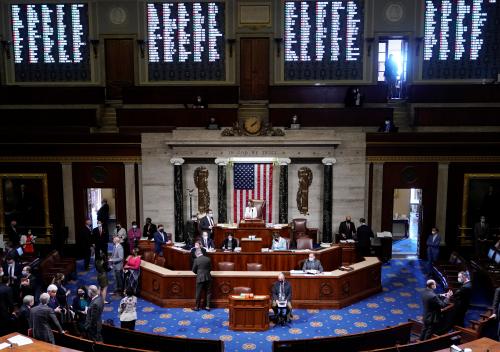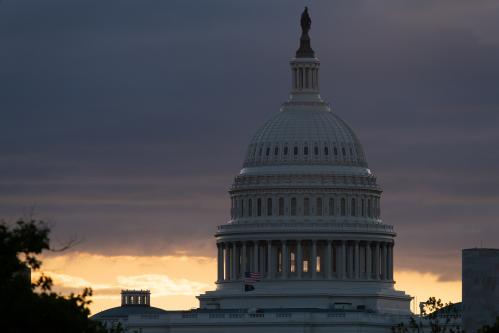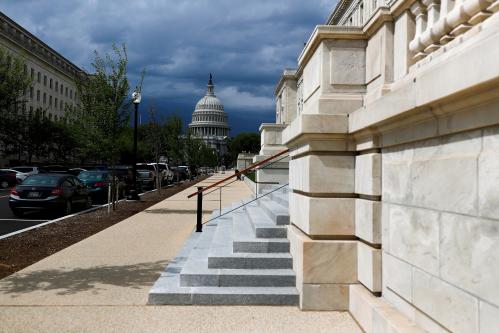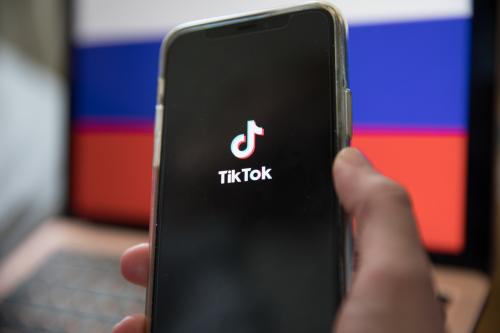On Monday, Rep. Bonnie Watson Coleman (D-N.J.) announced she had tested positive for COVID-19. A seventy-five-year-old cancer survivor, Rep. Watson Coleman had returned to the Capitol to be sworn in and certify electoral college votes—she had not voted in person since May, instead making use of the House proxy voting system allowing members to designate a colleague to cast their votes. Watson Coleman is now one of at least three members who contracted COVID just five days after being exposed to someone with the virus while sheltering in a secure room with Republican members who smugly refused to put on face masks.[1]
To date, over 100 members have either tested positive for the coronavirus or come into contact with someone who has COVID-19, and over 150 individuals who work within the Capitol complex have been infected. While members have already begun receiving the newly approved vaccines, it may still take months for enough staff to be vaccinated in order to safely return legislative buildings to full capacity.
Since its adoption in May 2020, the proxy voting system has been heavily politicized, with Republican leaders even filing a lawsuit against Speaker of the House Nancy Pelosi and other Democrats that questions the constitutionality of the system. As the House begins the 117th Congress with an extension of the proxy voting arrangement, how has the remote voting by proxy system been used by lawmakers thus far?
Use of remote voting by proxy in the 116th Congress
In the 116th Congress, 186 members of the House named a proxy designee at least once. Of these members 179 are Democrats, meaning nearly 75% of the caucus designated a proxy for at least part of the session. Only seven Republicans named proxies, and all but one of their designees were Democrats.[2] Members generally selected proxies with whom they share common characteristics; of those designated as proxies, 60% share membership in either an ideological caucus (the Congressional Progressive Caucus, the New Democrats Coalition, and the Blue Dog Caucus), the Congressional Black Caucus, or the Congressional Hispanic Caucus with the member selecting them as a proxy. Fifty-two percent are from the same region.
Following the election, there was a significant uptick in proxy usage, with 226 new designations. Twelve members who named designees since November 3rd are leaving the House after the 116th Congress; of these, eight named a proxy in this period for the first time, suggesting that the increase is driven both by the spread of COVID-19 and by retiring members who have less of an incentive to travel to Washington.[3]
Identifying members who have used their proxy designation to cast votes can also tell us more about how the remote voting system is being used.[4] In total, 6714 proxies were cast on 144 possible roll call votes. Members used the opportunity to vote from afar selectively, with a small group of members casting a significant portion of proxy votes. The average number of proxies cast per member who had named a designation was 37, while the median was only 17.
Republican criticism and a lawsuit
Congressional Republicans have been highly critical of the remote voting by proxy system. Shortly after passage, House Republicans filed a lawsuit in the U.S. District Court for the District of Columbia alleging the system was unconstitutional and a “dereliction of our duty.” The lawsuit has since been heard by the U.S. Court of Appeals and awaits a ruling there.
Republicans have also critiqued the proxy voting procedures outside of the courtroom. During a House Rules Committee member day hearing on October 1st, Ranking Member of the Committee on House Administration Rodney Davis (R-Ill.) asserted that “as infection rates stabilize, and in many states fall, proxy voting is being used in increased numbers, by up to 20% of all members” and that his office was seeing “increased use of proxy voting on Fridays,” suggesting that members were using the system to take a long weekend at home.
On Monday, Minority Leader Kevin McCarthy (R-Calif.) “gave his blessing” for Republican members to use the proxy system but advised any representative who designated a proxy to drop their participation in the lawsuit. Importantly, reports do not indicate whether McCarthy’s decision was prompted by the spread of the virus or because of increasing threats to GOP lawmakers from groups associated with Wednesday’s attack on the Capitol.
Is criticism of the proxy voting system warranted?
Evidence supporting Republican claims of abuse is mixed. Excluding the first week of proxy voting when members were eager to show the system could work, and a unique, isolated day of voting on Saturday, August 22nd, the average number proxies cast on each vote in the House increased gradually over time, mirroring the continued spread of COVID-19 throughout the United States. Evidence suggests that members utilized the system to keep themselves safe from the virus. Of the 14 members who cast all 144 votes since May 22nd by proxy, 13 are over the age of 60, and the other, Ted Lieu, recently had cardiac procedure making him a high-risk individual.
Accusations of members using the proxy voting system to take longer weekends, however, hold up under slightly higher scrutiny. One measure of “jet-fume” voting involves looking at the average votes by proxy on fly-in or fly-out days, or the first and last days of legislative business during any given week Congress was in session. Upon examination, votes that occurred on “fly-out” days, received nine more votes by proxy than votes held on a day during the middle of a weekly session. Depending on the week, however, members have also cast more votes by proxy on non-flying days, so critics should be hesitant to point to this measure as evidence of systemic abuse.
Table 1: Proxies cast per vote on congressional travel days
| Proxies Cast | Total Votes | Proxies Per Vote | |
| Fly-In Days | 1548 | 34 | 45.5 |
| Fly-Out Days | 2100 | 42 | 50.0 |
| Fly-In/Out Days (8/22, 12/28) | 519 | 6 | 86.5 |
| Normal Workday | 2547 | 62 | 41.1 |
Finally, while not systematically tracked, we have only identified one case of an improper exercise of proxy power. During the emergency session on August 22nd, both Rep. David Cicilline (D-R.I.) and Rep. Katherine Clark (D-Mass.) attempted to vote by proxy for Rep. Chellie Pingree (D-Maine). House Clerk Cheryl Johnson caught the discrepancy, and only Rep. Clark’s proxy was counted, as she was the proper designee.
Proxy voting in the 117th Congress
After a successful rollout of the proxy voting system, the House has instituted a similar process at the start of the 117th Congress. In addition, the Committee on House Administration published a staff report in early November 2020 concluding that a fully remote voting system would be technologically possible and operationally feasible, but it remains to be seen if such a system would be ready.
Over the coming weeks, remote voting can play a vital role in preserving the continuity of government as the spread of coronavirus continues to worsen. In the absence of widespread vaccination, continuing an alternative system of voting is key to protecting members, their staff, and the Capitol’s thousands of support staff.
[1] Rep. Pramila Jayapal (D-Wash.) and Rep. Brad Schneider (D-Ill.) have also tested positive.
[2] The Republican members who have named a proxy are Rooney (R-Fla.), Mitchell (R-Mich.), Gaetz (R-Fla.), Shimkus (R-Ill.), Gianforte (R-Mont.), Upton (R-Mich.), and Young (R-Alaska). On December 28th, Don Young named Rep. Brian Mast (R-Fla.) as a proxy but quickly revoked the designation before Mast voted for Young by proxy.
[3] Of the 8 departing members who named their first proxy following the election, 3 are Republicans (Mitchell, Shimkus, and Gianforte).
[4] Votes cast by proxy were identified using roll call data from the daily Congressional Record.
This work is licensed under the Creative Commons Attribution-NonCommerical-NoDerivatives 4.0 International License. To view a copy of the license, visit https://creativecommons.org/licenses/by-nc-nd/4.0/.
-
Acknowledgements and disclosures
The authors would like to thank Christian Potter and Mohammed Memfis for their data collection assistance.








Commentary
With House Republicans flouting COVID-19 guidelines, proxy voting remains an essential option
January 12, 2021